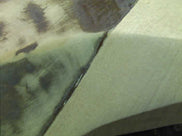1964 Fender J bass ....... kinda
Share
What were they thinking ...............................
This is a story I found on my old site and it's still one of my favorite repairs EVER for obvious reasons. I apologise in advance for the picture sizes as they were compressed small for my old site and I cant find the originals, but you get the idea.
This '64 J bass came to me looking like this. The guy had bought it, with ALL the original parts inc neck, pick ups and electronics etc from the local paper for a REALLY good price.
The new owner thought it was a right off and was going to buy a new or second hand Fender Japan or Allparts body off me and get me to swap all the hardware over. I looked at it and said "I can save this" He just looked at me weird !!!!
I started out cleaning up the edges that had been roughly cut so I could attach new "wings" on to cut the horns out. I set up jigs to rout straight edges so I had something to work with.
With the edges square and clean I started making the timber that would become the new horns. As I didn't have any mid sixties alder lying around and, in my opinion the horns don't effect tone I opted for some nice pieces of Queensland maple as it's reasonably light and easy to work with/shape.
It was really starting to take shape now and I could see the original J bass coming together.
The clamping method was ............. unconventional to say the least. I had to line up everything in 3D which took a while to work out but it came together well.
With the horns on, it was time to start carving the new wings to shape them gently into the old body. I've always admired sculptors for their art and didn't realize until doing this that I actually sculpt in wood all the time. My Wosrites were all German Carve by hand which is very 3D when done properly and a neck is all 3D carving.
Trying to follow the original body shapes was difficult because of the consistency and grain of the old timber as apposed to the new but it started coming together. It was a joy to watch this old body come back to it's original shape.
The original body had been sanded and shaped badly using what looked like a hand saw and an angle grinder, so some areas needed to be rebuilt to get back to shape. There were gouges in the body where it looked like someone had slipped with a grinding wheel.
All in all it was really coming together and just needed some finish prep work to get it ready to paint.
The owner wanted to paint it himself, which was a bit annoying after all this work, but here's what he picked up.
It has a coat of sealer on it as he wanted to try and finish it in a solid metallic red to match the headstock .......... Yeah, matching headstock !!!!


This sort of thing is certainly worth doing on a vintage piece like this. The bass was only worth what the parts were worth before, but now can be made back into something close to it's original glory.
Sure, it's not original but it should play like the real '64 J bass it is and is essentially more original than having a second hand Fender Japan body with old parts. Since the "tone" of the guitar body is down the middle (especially behind the bridge) and this part is still basically intact I can't see that this would sound any different to the same bass without this done and with a decent paint job should look pretty right too.
I don't know what year it was a good idea to cut the horns off a '64 Fender J bass ................ but we probably should have skipped it entirely, even at the risk of throwing out the whole space/time continuum.


















